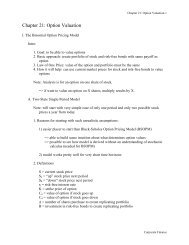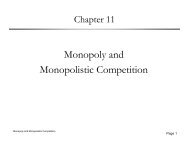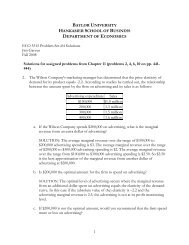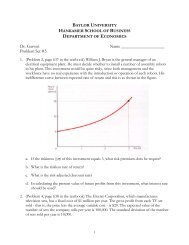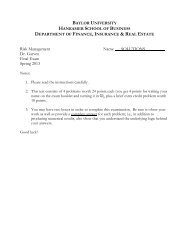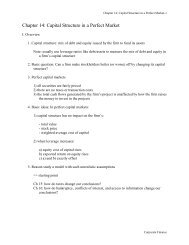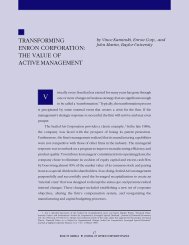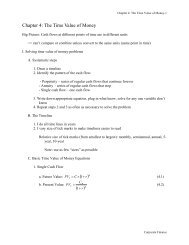Insurance Company Capital Structure Swaps and Shareholder Wealth
Insurance Company Capital Structure Swaps and Shareholder Wealth
Insurance Company Capital Structure Swaps and Shareholder Wealth
You also want an ePaper? Increase the reach of your titles
YUMPU automatically turns print PDFs into web optimized ePapers that Google loves.
Table 8: Comparative Statics<br />
Comparative statics showing the predicted optimal capital structure swap given managers’ private information<br />
about expected loss <strong>and</strong> volatility estimates of loss reserve. “Market higher” means that compared<br />
with loss or volatility estimates under private information, managers believe the market has overstated the<br />
expected loss or volatility. “No difference” means that the managers’ private information agrees with market<br />
estimates. “Market lower” means that managers believe the market estimates of loss <strong>and</strong> volatility are too<br />
low.<br />
Volatility:<br />
Expected Loss:<br />
Market Higher No Difference Market Lower<br />
Market Higher Issue equity in some<br />
cases<br />
Always issue equity Always issue equity<br />
No Difference Always retire equity Do nothing Always issue equity<br />
Market Lower Always retire equity Always retire equity Either action will add<br />
value<br />
7 Conclusion<br />
Prior research has demonstrated that in most cases, firms that issue equity do so at the expense of<br />
the controlling shareholders. Some research, however, has demonstrated that insurance company<br />
investors, in particular, may benefit from a different regulatory system that addresses many of the<br />
information asymmetry problems associated with new equity issues. Further research has shown<br />
that insurers gain many advantages from purchasing reinsurance, including comparative advantages<br />
in risk-bearing <strong>and</strong> provision of real services. When the managers can exploit risk aversion of<br />
potential policyholders to sell insurance at a premium to expected loss, they can increase the<br />
firm’s leverage <strong>and</strong> use the proceeds to retire equity or invest in new projects. At the same time,<br />
if managers can purchase value-adding reinsurance, they may choose to issue equity to raise the<br />
necessary cash to do so.<br />
In this paper, we show that insurance companies have unique opportunities to engage in capital<br />
structure arbitrage by executing transactions that take advantage of market conditions <strong>and</strong> frictions.<br />
We use a Merton-Margrabe option pricing model to analyze the impact of an exchange of risky<br />
35



